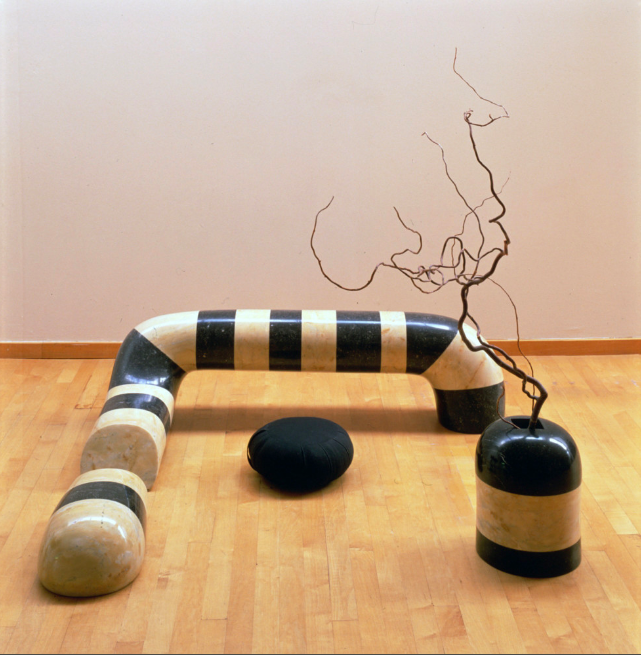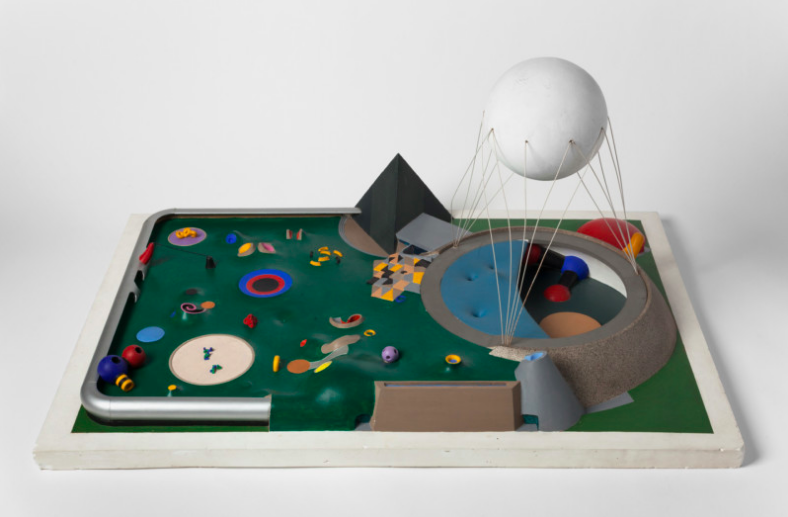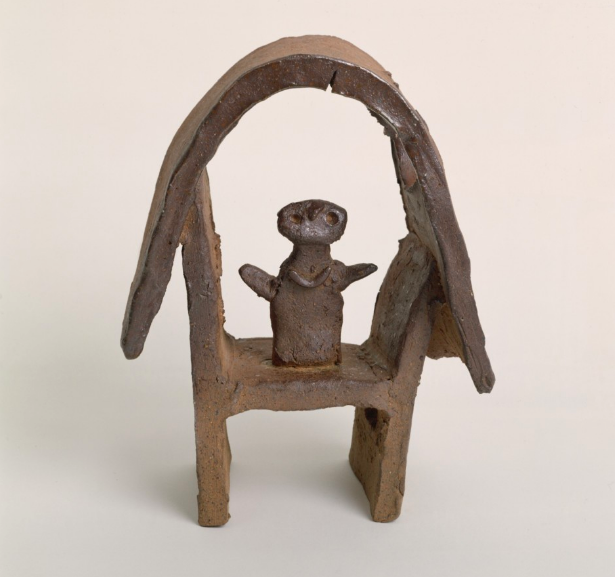[Most Recent Entries] [Calendar View]
Thursday, November 28th, 2019
| Time | Event |
| 3:00p | The Isamu Noguchi Museum Puts Online an Archive of 60,000 Photographs, Manuscripts & Digitized Drawings by the Japanese Sculptor
No matter how unfamiliar you may be with the work of Isamu Noguchi, you're likely to have encountered it, quite possibly more than once, in the form of a Noguchi table. Designed in the 1940s for the Herman Miller furniture company (in a catalog that also included the work of George Nelson, Paul László, and Charles Eames of the eponymous chair), it shows off Noguchi's distinctive aesthetic as well as many of his most acclaimed sculptures, set designs, and public spaces. That aesthetic could only have arisen from a singular artistic life like Noguchi's, which began in Los Angeles where he was born to an American mother and a Japanese father, and soon started crossing back and forth across both the Pacific and the Atlantic: a childhood spent around Japan, schooling and apprenticeship back in the U.S., a Guggenheim Fellowship in Paris, periods of study in China and Japan — and all that before age 30.
Now, thanks to the Noguchi Museum, we can take a closer look at not just the Noguchi table but all the fruits of Noguchi's long working life, which began in the 1910s and continued until his death in the 1980s. (He executed his first notable work, the design of the garden for his mother's house in Chigasaki, at just eight years old.) The institution that bears his name recently digitized and made available 60,000 archival photographs, manuscripts, and digitized drawings, and also launched a digital catalogue raisonné designed to be updated with discoveries still to come about Noguchi's life and work. "The completion of a multiyear project, the archive now features 28,000 photographs documenting the artist’s works, exhibitions, various studios, personal photographs, and influential friends and colleagues," writes Hyperallergic's Alissa Guzman. "The wealth of imagery is overwhelming and also surprising, bringing attention to works we might not often associate with Noguchi."
Indeed, as the project's managing editor Alex Ross tells Guzman, the research process revealed "several significant artworks which were assumed to have been lost or destroyed," as well as "previously unattributed pieces that the archive is now able to confirm as works by Noguchi." The difficulty of confirming the authenticity of certain works speaks to the protean quality of Noguchi's art that goes hand-in-hand with its distinctiveness, a balance struck by few major artists of any era. And though quite a few of Noguchi's creations (and not just the table) have been described as timeless, no other body of work reflects quite so clearly the intermingling of East and West – a West that included the Old World as well as the New — that, having begun on economic and social levels, reached the aesthetic one in the century through which Noguchi lived. Explore his catalogue raisonné, and you may find that, no matter what part of the world you're from, you have more experience with Noguchi's work than you thought.
via Hyperallergic Related Content: The Getty Digital Archive Expands to 135,000 Free Images: Download High Resolution Scans of Paintings, Sculptures, Photographs & Much Much More Download 2,500 Beautiful Woodblock Prints and Drawings by Japanese Masters (1600-1915) Based in Seoul, Colin Marshall writes and broadcasts on cities, language, and culture. His projects include the book The Stateless City: a Walk through 21st-Century Los Angeles and the video series The City in Cinema. Follow him on Twitter at @colinmarshall or on Facebook. The Isamu Noguchi Museum Puts Online an Archive of 60,000 Photographs, Manuscripts & Digitized Drawings by the Japanese Sculptor is a post from: Open Culture. Follow us on Facebook, Twitter, and Google Plus, or get our Daily Email. And don't miss our big collections of Free Online Courses, Free Online Movies, Free eBooks, Free Audio Books, Free Foreign Language Lessons, and MOOCs. |
| 7:35p | William S. Burroughs Reads His “Thanksgiving Prayer” in a 1988 Film By Gus Van Sant Having moved to Korea a couple weeks ago, I won't have the chance to partake this year in the beloved institution of American culture known as Thanksgiving. (Korea has its own Thanksgiving, but it happened two months ago.) Maybe you live in the United States and thus almost certainly have a Thanksgiving dinner of some kind, big or small, coming soon. Or maybe you, like me, live elsewhere in the world, and thus in a place without the same tradition. Either way, you can surely partake this Thanksgiving in the beloved institution of American culture known as the work of William S. Burroughs. Here we have a short film of Burroughs, best known as the author of a body of controversial and experimental literature, including books like Junky and Naked Lunch, shot by Gus Van Sant, best known as the director of films like Good Will Hunting, My Own Private Idaho, and Drugstore Cowboy, the last of which includes a memorable appearance by Burroughs himself. It captures Burroughs reading his poem “Thanksgiving Day, Nov. 28, 1986,” also known as his "Thanksgiving Prayer." Van Sant shot it two Thanksgivings after that one, in 1988, the year before Drugstore Cowboy (and six years after adapting Burrough's story "The Discipline of D.E." into an early short film). Burroughs, a lifelong critic of America, fills his prayer with bitterly sarcastic "thanks" for things like "a continent to despoil and poison," "Indians to provide a modicum of challenge and danger," "the KKK," and "Prohibition and the war against drugs" (about which his character in Drugstore Cowboy had some particularly choice words). He ends by expressing ironic, Great Gatsby-quoting gratitude for "the last and greatest betrayal of the last and greatest of human dreams." Like him — like most everybody — I have my own, if less deep-seated, frustrations with our homeland, and perhaps in leaving I subconsciously emulated his stretches of expatriatism in Mexico, England, France, and Morocco. But I sincerely doubt that I've had my last Thanksgiving on U.S. soil; for all its failings, America remains too interesting to stay away from entirely. After all, what other country could possibly produce a writer, a personality, or a critic like William S. Burroughs? Note: An earlier version of this post appeared on our site in 2015. Related Content: How David Bowie Used William S. Burroughs’ Cut-Up Method to Write His Unforgettable Lyrics The Making of Drugstore Cowboy, Gus Van Sant’s First Major Film (1989) William S. Burroughs Teaches a Free Course on Creative Reading and Writing (1979) The Discipline of D.E.: Gus Van Sant Adapts a Story by William S. Burroughs Based in Seoul, Colin Marshall writes and broadcasts on cities and culture. He’s at work on a book about Los Angeles, A Los Angeles Primer, the video series The City in Cinema, and the crowdfunded journalism project Where Is the City of the Future? Follow him on Twitter at @colinmarshall or on Facebook. William S. Burroughs Reads His “Thanksgiving Prayer” in a 1988 Film By Gus Van Sant is a post from: Open Culture. Follow us on Facebook, Twitter, and Google Plus, or get our Daily Email. And don't miss our big collections of Free Online Courses, Free Online Movies, Free eBooks, Free Audio Books, Free Foreign Language Lessons, and MOOCs. |
| 7:59p | An Illustrated Map of Every Known Object in Space: Asteroids, Dwarf Planets, Black Holes & Much More Name all the things in space in 20 minutes. Impossible, you say? Well, if there’s anyone who might come close to summarizing the contents of the universe in less than half an hour, with the aid of a handy infographic map also available as a poster, it's physicist Dominic Walliman, who has explored other vast scientific regions in condensed, yet comprehensive maps on physics, mathematics, chemistry, biology, and computer science. These are all academic disciplines with more or less defined boundaries. But space? It’s potentially endless, a point Walliman grants up front. Space is “infinitely big and there are an infinite number of things in it," he says. However, these things can still be named and categorized, since “there are not an infinite number of different kinds of things.” We begin at home, so to speak, with the Earth, our Sun, the solar system (and a dog), and the planets: terrestrial, gas, and ice giant. Asteroids, meteors, comets, dwarf planets, moons, the Kuyper Belt, Dort Cloud, and heliosphere, cosmic dust, black holes…. We’re only two minutes in and that’s a lot of things already—but it’s also a lot of kinds of things, and those kinds repeat over and over. The supermassive black hole at the center of the Milky Way may be a type representing a whole class of things “at the center of every galaxy." The universe might contain an infinite number of stars—or a number so large it might as well be infinite. But that doesn’t mean we can’t extrapolate from the comparatively tiny number we’re able to observe as representative of general star behavior: from the “main sequence stars”—Red, Orange, and Yellow Dwarves (like our sun)—to blue giants to variable stars, which pulsate and change in size and brightness. Massive Red Giants explode into nebulae at the end of their 100 million to 2 billion year lives. They also, along with Red and Orange Dwarf stars, leave behind a core known as a White Dwarf, which will become a Black Dwarf, which does not exist yet because the universe it not old enough to have produced any. “White dwarves,” Walliman says, “will be the fate of 97% of the stars in the universe." The number of kinds of stars expands, we get into the different shapes galaxies can take, and learn about cosmic radiation and “mysteries.” This project does not have the scope to include explanations of how we know about these many kinds of space objects, but Walliman does an excellent job of turning what may be the biggest picture imaginable into a thumbnail—or poster-sized (purchase here, download here)—outline of the universe. We cannot ask more from a twenty-minute video promising to name “Every Kind of Thing in Space.” See other science-defining video maps, all written, researched, animated, edited, and scored by Walliman, at the links below. Related Content: The Map of Physics: Animation Shows How All the Different Fields in Physics Fit Together The Map of Mathematics: Animation Shows How All the Different Fields in Math Fit Together The Map of Chemistry: New Animation Summarizes the Entire Field of Chemistry in 12 Minutes The Map of Biology: Animation Shows How All the Different Fields in Biology Fit Together Josh Jones is a writer and musician based in Durham, NC. Follow him at @jdmagness An Illustrated Map of Every Known Object in Space: Asteroids, Dwarf Planets, Black Holes & Much More is a post from: Open Culture. Follow us on Facebook, Twitter, and Google Plus, or get our Daily Email. And don't miss our big collections of Free Online Courses, Free Online Movies, Free eBooks, Free Audio Books, Free Foreign Language Lessons, and MOOCs. |
| 8:00p | The Illustrated Version of “Alice’s Restaurant”: Watch Arlo Guthrie’s Thanksgiving Counterculture Classic Alice’s Restaurant. It’s now a Thanksgiving classic, and something of a tradition around here. Recorded in 1967, the 18+ minute counterculture song recounts Arlo Guthrie’s real encounter with the law, starting on Thanksgiving Day 1965. As the long song unfolds, we hear all about how a hippie-bating police officer, by the name of William "Obie" Obanhein, arrested Arlo for littering. (Cultural footnote: Obie previously posed for several Norman Rockwell paintings, including the well-known painting, "The Runaway," that graced a 1958 cover of The Saturday Evening Post.) In fairly short order, Arlo pleads guilty to a misdemeanor charge, pays a $25 fine, and cleans up the thrash. But the story isn't over. Not by a long shot. Later, when Arlo (son of Woody Guthrie) gets called up for the draft, the petty crime ironically becomes a basis for disqualifying him from military service in the Vietnam War. Guthrie recounts this with some bitterness as the song builds into a satirical protest against the war: "I'm sittin' here on the Group W bench 'cause you want to know if I'm moral enough to join the Army, burn women, kids, houses and villages after bein' a litterbug." And then we're back to the cheery chorus again: "You can get anything you want, at Alice's Restaurant." We have featured Guthrie’s classic during past years. But, for this Thanksgiving, we give you the illustrated version. Happy Thanksgiving to everyone who plans to celebrate the holiday today. Would you like to support the mission of Open Culture? Please consider making a donation to our site. It's hard to rely 100% on ads, and your contributions will help us continue providing the best free cultural and educational materials to learners everywhere. Also consider following Open Culture on Facebook and Twitter and sharing intelligent media with your friends. Or sign up for our daily email and get a daily dose of Open Culture in your inbox. Related Content: William S. Burroughs Reads His Sarcastic “Thanksgiving Prayer” in a 1988 Film By Gus Van Sant Marilyn Monroe’s Handwritten Turkey-and-Stuffing Recipe William Shatner Raps About How to Not Kill Yourself Deep Frying a Turkey F. Scott Fitzgerald’s 13 Tips for What to Do with Your Leftover Thanksgiving Turkey The Illustrated Version of “Alice’s Restaurant”: Watch Arlo Guthrie’s Thanksgiving Counterculture Classic is a post from: Open Culture. Follow us on Facebook, Twitter, and Google Plus, or get our Daily Email. And don't miss our big collections of Free Online Courses, Free Online Movies, Free eBooks, Free Audio Books, Free Foreign Language Lessons, and MOOCs. |
| << Previous Day |
2019/11/28 [Calendar] |
Next Day >> |






